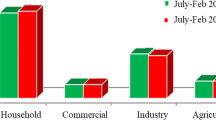Abstract
Decomposition analysis is useful method to determine significant factors contribute towards the development of energy consumption. This paper presents factors decomposition of electricity consumption in Indonesia’s household sector using artificial intelligent method. The proposed artificial intelligent technique used in this study is the Neuro Fuzzy Takagi-Sugeno (NFTS) network, which is worked under multiple input multiple output condition. By tuning the appropriate Gaussian parameters, which are mean and variance, and two Takagi-Sugeno weight, the changes in electricity consumption that is decomposed into production effect, structural effect, and efficiency effect, has revealed. Compared to the common method, the performance of NFTS network for both constant and current price variables is quite satisfied, given the error generated in the network ranges between 0.003 and 2.09 %, which is quite low and acceptable.
Access this chapter
Tax calculation will be finalised at checkout
Purchases are for personal use only
Similar content being viewed by others
References
Achao, C., Schaeffer, R.: Decomposition analysis of the variations in residential electricity consumption in Brazil for the 1980–2007 period: Measuring the activity, intensity and structure effects. Energy Policy 37(12), 5208–5220 (2009)
Chung, W., et al.: A study of residential energy use in Hong Kong by decomposition analysis 1990–2007. Appl. Energy 88(12), 5180–5187 (2011)
Tanoto, Y., Praptiningsih, M.: Factors decomposition of Indonesia’s household electricity consumption. Eng. J. 17(2), 19–28 (2013)
Pasila, F., Alimin, R., Natalius, H.: Neuro-fuzzy architecture of the 3D model of massive parallel actuators. ARPN J. Eng. Appl. Sci. 9(12), 2900–2905 (2014)
S. Corporate: PLN Statistics 2010. PT. PLN (Persero), Jakarta, Indonesia (2011)
Bank Indonesia: Special Data Dissemination Standard. http://www.bi.go.id/sdds/series/NA/index_NA.asp (2010)
Author information
Authors and Affiliations
Corresponding author
Editor information
Editors and Affiliations
Rights and permissions
Copyright information
© 2016 Springer Science+Business Media Singapore
About this paper
Cite this paper
Tanoto, Y., Pasila, F. (2016). Energy Decomposition Model Using Takagi-Sugeno Neuro Fuzzy. In: Pasila, F., Tanoto, Y., Lim, R., Santoso, M., Pah, N. (eds) Proceedings of Second International Conference on Electrical Systems, Technology and Information 2015 (ICESTI 2015). Lecture Notes in Electrical Engineering, vol 365. Springer, Singapore. https://doi.org/10.1007/978-981-287-988-2_16
Download citation
DOI: https://doi.org/10.1007/978-981-287-988-2_16
Published:
Publisher Name: Springer, Singapore
Print ISBN: 978-981-287-986-8
Online ISBN: 978-981-287-988-2
eBook Packages: EngineeringEngineering (R0)




